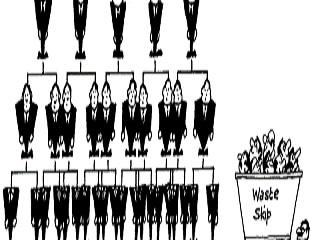Is hierarchy out of fashion?
| Datum: | 24 oktober 2014 |
| Auteur: | Roxana Bucur |

The contemporary business world is characterized by organizations that tend to decline in formality, or more specifically, to shift from formal hierarchical structures to informal ones (Diefenbach & Sillince, 2011), where all employees that are situated on equal positions (Leavitt, 2005). In such group settings, hierarchy still develops, because individuals spontaneously form inferences about each other, and such inferences often result in an informal hierarchical order that guides their interactions (Magee and Galinsky, 2008). This makes us wonder: is formal hierarchy out of fashion?
An example that illustrates the trend of companies deviating from formal hierarchical structures comes from Google. This company amazed its public with its creativity (think for example of the self-driving car) but also with bold choices in terms of organizational management. In 2002, Google thought that managers are not needed in their organizational schema, so they decided to just eliminate managers from their hierarchical organization. Google’s technology director, made public this catchphrase “managers are just adding levels of bureaucracy.” This daring trial lasted only for a couple of months as they realized that managers were actually useful: they solved conflicts and answered questions. Therefore, it seems that hierarchies might become less trendy, but they are certainly useful.
In other words, even if companies might think they do not need hierarchy and that working in a flat organization is possible and efficient, research proves them wrong. Hierarchies are enhancing group chances of survival and success; they provide teams with a psychological appealing kind of order that clarifies roles and facilitate coordination: “the performance of work groups and department depends in part on their levels of hierarchical differentiation” (Magee & Galinsky, 2008).
Hierarchies might be old-fashioned, but they are ubiquitous and research shows this in a recently published article by the Journal of Personality and Social Psychology. Authors reveal that hierarchies are prevalent in organizations because they offer structure and satisfy individual’s need for order and control (Friese, Kay, Eibach & Galinsky, 2014). This paper is the first to show evidence for compensatory nature of hierarchies; that they are also an external source for structure for people across all ranks in the hierarchy. In other words, researchers suggest that hierarchy is not only supported by higher ranked individuals, but also by lower ranked ones; one underlying reason might be that low- ranked individuals believe that the social structure offered by hierarchies compensates for situation of low personal control. Conclusively, this recent work boosts previous research findings by experimentally showing that motivational needs for structure may explain, in part, the charm of hierarchy. Hierarchy might be old, or even old-fashioned and criticized by many organizations in search for egalitarianism, but hierarchies have a way of making it into the spotlight; this time Friesen et al., (2014) brought them back in style by explaining their psychological advantages.
References
Diefenbach, T., & Sillince, J. A. A. (2011). Formal and informal hierarchy in different types of organization. Organization Studies, 32, 1515-1537.
Leavitt, H. J. (2005). Hierarchies, authority, and leadership. Leader to leader. 37, 55-61.
Magee, J. C., & Galinsky, A. D. (2008). Social hierarchy: The self-reinforcing nature of power and status. Academy of Management Annals, 2, 351-398.
Friese, J.P., Kay, A. C., Eibach, R.P. & Galinsky, A. D. (2014). Seeking structure in social organization: Compensatory control and the psychological advantages of hierarchy. Journal of Personality and Social Psychology, 4, 590- 609.


